
MAY CONTAIN NUTS

Search Shorpy
SHORPY ART

Framed or unframed, desk size to sofa size, printed by us in Arizona and Alabama since 2007. Explore now.
Join and Share
Ad-Free Shorpy
Shorpy is funded by you. Patreon contributors get an ad-free experience.
Learn more.

Recent comments
- Yellow sky at morning
- Side Winder
- Air Quality?
- Sojourner Truth riot
- None were so blind(ed)
- The less famous sister
- Good ol' days?
- Rise and Fall
- Goo Goo Ga Joob
- Ticket Retention
- Not the only one
- Vagaries of War
- Killed by Amtrak
- Back to the Future
- Wanted --
- If you can't stand the light
- Centralized Traffic Control, I believe
- What's really happening
- Heckuva remote control!
- Sometimes — Things Go Bump!
- I SEE THE LIGHT
- Union Switch and Signal Company
- Get That Light Out Of My Eyes
- Eggs. Eggs. Eggs. The Egg Man is Here!
- Foreboding caption
- Famous Hollywood faces
- Not just S&P
- re: Those things in the jar
- Up In Smoke
- Medical Smoking
Member Photos
The Shorpy
Print Emporium
Print Emporium
Search Shorpy
Search results -- 30 results per page
- Jupiter Narrows: 1890
- ... landing in Jupiter Narrows." 5x7 inch glass negative by William Henry Jackson. View full size.
Very narrow I grew up in Eau Gallie ... Posted by Dave - 03/14/2019 - 3:46pm -
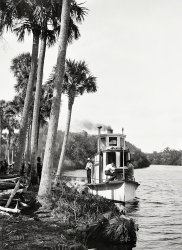
- Hasell Street: 1902
- ... from this earlier view . 8x10 inch glass negative by William Henry Jackson, Detroit Publishing Co. View full size.
+108 Below is ... Posted by Dave - 08/21/2012 - 6:59pm -
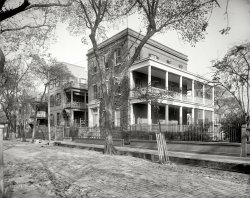
- The French Quarter: 1890s
- ... glass negative, taken sometime between 1880 and 1898 by William Henry Jackson. View full size.
L. INTERGUGLIELMI, PHOTOGRAPHER 227 ... Posted by Dave - 03/14/2019 - 7:05pm -
![The French Quarter: 1890s "Street in the French Quarter, New Orleans." At left, the portrait studio of photographer Louis Interguglielmi, 227 Royal Street. 5x7 glass negative, taken sometime between 1880 and 1898 by William Henry Jackson. View full size.
L. INTERGUGLIELMI, PHOTOGRAPHER227 Royal Street, according to the 1893 New Orleans City Directory. Below, the sign over the door, unsquashed by Photoshop.
Nice name!Having studied Italian and married into an Italian family I take a strange pleasure in being able to pronounce that auspicious surname with ease!
Hold your noseA fascinating scene to look at, but I'm glad I don't have to smell it.
Son of Eugenio?In Sicily (Italy) there was a photographer Eugenio Interguglielmi (1850-1911), I could not find if the two were related. At some moment in time the L. Interguglielmi Photography Studio has been located at New 933 Royal St., between Dumaine and St. Philip.
Ruts! Decades of steel rimmed wheels have left some serious ruts in the stone. At least, I assume that's what they are.
[Those are for streetcar tracks. - Dave]
(The Gallery, DPC, New Orleans, W.H. Jackson)](https://www.shorpy.com/files/images/SHORPY-4a26982a.thumbnail.jpg)
- Circle in the Sand: 1901
- ... Panorama made from two 8x10 inch glass negatives. Photo by William Henry Jackson. View full size.
Sand or snow Looks almost like Duluth ... Posted by Dave - 08/03/2021 - 12:33pm -
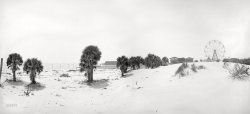
- A Tisket, a Tasket: 1906
- ... probably delicious food. 8x10 inch glass negative by William Henry Jackson. View full size.
Peanuts I would guess parched ... Posted by Dave - 11/06/2011 - 3:21pm -
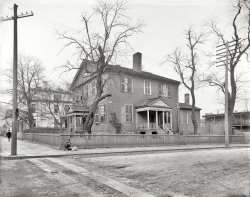
- Bonaventure Cemetery: 1901
- ... Cemetery, Savannah, Georgia." 8x10 inch glass negative by William Henry Jackson. Detroit Photographic Company. View full size.
Woah! ... Posted by Dave - 01/18/2015 - 3:46pm -
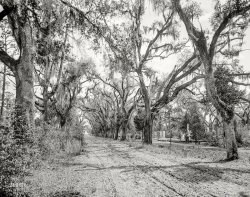
- Fifth Avenue Hotel: 1901
- ... of Madison Square." 8x10 inch dry plate glass negative by William Henry Jackson. View full size.
Roof Masts On the hotel roof and the ... Posted by Dave - 09/10/2018 - 2:44pm -
![Fifth Avenue Hotel: 1901 New York circa 1901. "Fifth Avenue Hotel, southwest corner of Madison Square." 8x10 inch dry plate glass negative by William Henry Jackson. View full size.
Roof MastsOn the hotel roof and the three buildings to the right of it looks like at least 30-foot masts. Too early for radio.
[Wireless telegraphy got its start in the 1890s, so it's not "too early for radio." But those are flagpoles. - Dave]
Interesting TrackworkStreetcar lines on both streets are powered by underground conduits, but only horsecars or trailers could use the curved connection tracks.
SewardStatue of William H. Seward, Secretary of State who negotiated the Alaska purchase in 1867 for $7.2 million, by sculptor Randolph Rogers.
Early MorningJudging by shadows, low sun in the southwestern sky, and the relative lack of people, this photo looks like it was taken pretty early in the morning.
[The shadows show the sun to be overhead, not low on the horizon. - Dave]
(The Gallery, Bicycles, DPC, NYC, Streetcars, W.H. Jackson)](https://www.shorpy.com/files/images/SHORPY-4a06255a.thumbnail.jpg)
- Long Train Running: 1900
- ... & North Western Railway." 8x10 glass negative by William Henry Jackson. View full size.
The Kate Shelley High Bridge Finally ... Posted by Dave - 10/20/2016 - 5:23pm -
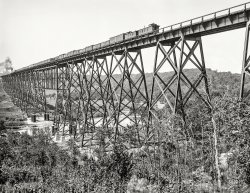
- Annisquam Light: 1910
- ... The lighthouse photo didn't use film, either. Taken by William Henry Jackson, it was the basis for this photochrom postcard dated 1904. - ... Posted by Dave - 07/20/2012 - 1:34pm -
![Annisquam Light: 1910 Circa 1910. "Annisquam Light. Gloucester, Massachusetts." Detroit Publishing Company glass negative, Library of Congress. View full size.
Panchromatic filmThe dramatic skies are unusual for photos of this age. Most, if not all, of the emulsions used by photographers was orthochromatic (sensitive to blue and green light). It is true that panchromatic dyes were invented in 1904 (sensitive to all colors including red). And apparently this photographer had the red or orange filter necessary to make such dramatic skies. Alternatively, the picture has the wrong date. The other question is the relatively high ISO that allowed for a fast shutter speed and great depth of field. Aside from those puzzles it is a wonderful image.
[This photograph was made on glass, not film. - Dave]
Re: Panchromatic filmI've been following a the comments here for about a year now, and it always tickles me when the supposedly knowlegeable people expounding on this or that aspect of photography back in the Civil War era or early 1900s keep referring to "film."
Still looking good
It's still there.The lighthouse is still there (Wigwam Point, MA) but the photo is a reversed mirror image. The pier is gone and some other changes have been made through the years, but not much has changed at Wigwam Point.
[Your are correct. Maybe someone put the negative in the scanning frame backward when it was digitally imaged. In any case I've flopped it back again to conform with reality. - Dave]
Annisquam LightI drink it all day.
Film or plate?I probably didn't make the point carefully enough, but I don't think there were panchromatic "plates" - there was only panchromatic film to my knowledge. Maybe someone else knows more about that. I note in a later post that the "negative" was inadvertently reversed. I'm not sure of the process here where a "negative" is used for the scan or a plate.
[Like it says in the caption under the photo, this image was made from a glass-plate negative. - Dave]
Gone FishinI see lots of boats but no people in them. What's going on?
[There's a man rowing in the boat next to the rocks. As for the rest, little boats are like bicycles. They spend most of their time not being used. - Dave]
Sui generisThere is not another example on Shorpy of an image showing such detail in the skies in 1910.There has to be an explanation for this rather than just citing the LOC.
[There are more than a few, actually. The clouds that do show up tend to be low in the sky, as they are here. (Below, Nashville in 1864; click to enlarge.) Because the old emulsions were more sensitive to short (ultraviolet and blue) wavelengths than modern panchromatic b&w emulsions, high clouds tended to register only faintly, and 19th-century skies as depicted in photographs tend to be rather featureless and overexposed-looking. That's only a general rule, though. There are plenty of exceptions. - Dave]
A five minute exposureI appreciate the opportunity to understand these pictures. The image from Nashville is a long exposure, perhaps 5 minutes, perhaps more. What you have in the Annisquam Light is an almost instantaneous exposure that also has deep depth of field. And, in addition, there is the fleecy and round character of the clouds. There is no way to get there without a film emulsion that records all of the spectrum of light, which is what panchromatic emulsions did. I categorically state that you will not find another image that has all of these characteristics. And therefore, the description is wrong.
[Exposure times for outdoor glass plate photography in the 1860s were measured in seconds, not minutes. Below, an 1864 glass negative by Samuel Cooley, which, judged by the passage of the boat, couldn't have been exposed more than a few seconds. "Film emulsion" wouldn't enter into the discussion -- no film was used the the making of this picture; film didn't even exist during the Civil War. The lighthouse photo didn't use film, either. Taken by William Henry Jackson, it was the basis for this photochrom postcard dated 1904. - Dave]
(The Gallery, Boats & Bridges, DPC, W.H. Jackson)](https://www.shorpy.com/files/images/4a28702u_0.thumbnail.jpg)
- Vacation Spots: 1890s
- ... Florida, circa 1890s. "The Ponce de Leon, rear view." Henry Flagler's grand hotel, with the street traffic none too artfully stippled out. 8x10 inch glass negative by William Henry Jackson. View full size.
(The Gallery, Detroit Photos, ... Posted by Dave - 05/26/2013 - 1:50pm -
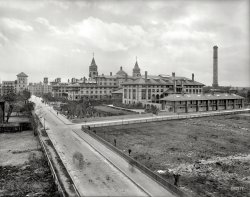
- Fun in the Sun: 1901
- ... "The Royal Poinciana, from northwest." A mere fraction of Henry Flagler's immense hotel , at one time the largest wood-frame structure in the world. 8x10 glass negative by William Henry Jackson. View full size.
Amazingly This hotel survived ... Posted by Dave - 01/25/2014 - 11:47am -
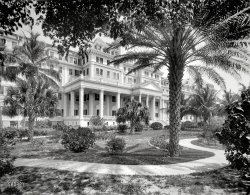
- U.S. Treasury: 1897
- ... Washington, D.C." 8x10 inch dry plate glass negative by William Henry Jackson, Detroit Photographic Co. View full size.
Swept Away ... Posted by Dave - 05/19/2018 - 4:11pm -
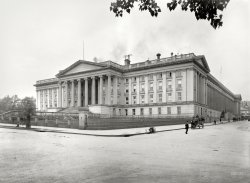
- Newer Orleans: 1890s
- ... the way to an electrified future. Glass negative by William Henry Jackson. View full size.
Creating a Smooth Ride This picture ... Posted by Dave - 03/16/2019 - 11:20am -
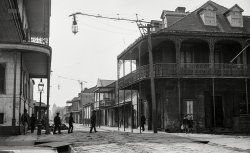
- Laurel in the Pines: 1901
- ... in 1967. Composite of two 8x10 inch glass negatives by William Henry Jackson. View full size.
Replaced by Ugly
Stunning! ... Posted by Dave - 07/03/2018 - 1:44pm -
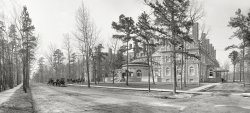
- Mississippi Gin: 1890
- ... the break room? 8x10 inch dry plate glass transparency by William Henry Jackson. View full size.
Is It Christmas? Now I know where all ... Posted by Dave - 05/25/2016 - 5:26pm -
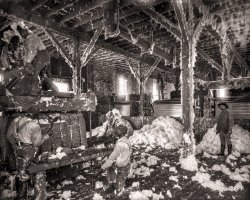
- Bostrom's: 1890
- ... Bostrom brothers. 8x10 inch dry plate glass negative by William Henry Jackson. View full size.
The Bosarve, on Riverside Drive. ... Posted by Dave - 03/12/2018 - 2:24pm -
![Bostrom's: 1890 Volusia County, Florida, circa 1890. "Bostrom's on the Halifax near Ormond." A tourist boarding house built by the town's first settlers, the Bostrom brothers. 8x10 inch dry plate glass negative by William Henry Jackson. View full size.
The Bosarve, on Riverside Drive. From ormondhistory.org:
John Andrew Bostrom is considered Ormond’s first settler, having homesteaded land with his brother Charles on the east side of the Halifax River in the late 1860s. By 1869, Bostrom observed a steady stream of visitors. To remedy the lack of tourist accommodations in the area, the Bostrom brothers and their two sisters expanded their home to make it into a boarding house. By the1880s, their hospitality had become well-known. Their venture into tourism had become a success.
Jedi?The man in front of the tree appears to be levitating some object.
[It's a swing. It's a bird feeder. It's a swing AND a bird feeder! Suspended by strings from a rope. - Dave]
That's a different way --Usually, I sse either a forked stick or a pair of bent rods!
True FloridianAll the folks here at the home said that its a plant pot holder
(The Gallery, DPC, Florida, W.H. Jackson)](https://www.shorpy.com/files/images/SHORPY-4a03529a.thumbnail.jpg)
- Colorado Springs: 1910
- ... Tejon Street." 5x7 inch dry plate glass negative by William Henry Jackson. View full size.
"What the---?" It looks ... Posted by Dave - 09/05/2017 - 12:21pm -
![Colorado Springs: 1910 Colorado Springs circa 1910. "Exchange National Bank Building, Tejon Street." 5x7 inch dry plate glass negative by William Henry Jackson. View full size.
"What the---?"It looks like the fellows in the auto are aware of the distant cameraman
Walk this wayThis is about the earliest photo in which I've seen designated & marked crosswalks. And most, but not all, of the pedestrians are actually using them!
[I think that's due to their being the only part of the street that's not dirt or mud. -tterrace]
It's still standing!Hasn't burnt down yet! If you look down the cross street to the right, you will see the majestic Pike's Peak. In the background, on the far left of the photo, you can just make out Cheyenne Mountain, home of NORAD, or whatever they call it now.
(The Gallery, Streetcars, W.H. Jackson)](https://www.shorpy.com/files/images/SHORPY-4a27358a1.thumbnail.jpg)
- The Ohio Building: 1906
- ... alternative, despite the cost. Yet I look at the photo of William Henry Jackson in his private railroad car (post-dated by a decade at least, ... Posted by Dave - 03/04/2022 - 10:59pm -
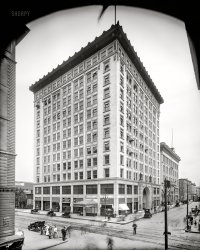
- Home Improvement: 1894
- ... oldest city. 8x10 inch dry plate glass negative by William Henry Jackson. View full size.
Clever Improvements Since Still looks ... Posted by Dave - 03/09/2019 - 5:39pm -
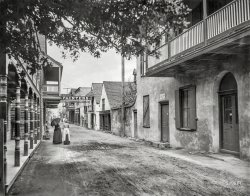
- Crossing Canal: 1890
- ... Hotel from Canal Street." 5x7 inch glass negative by William Henry Jackson. View full size.
Look Closely Those streetcars have ... Posted by Dave - 03/17/2019 - 9:47am -
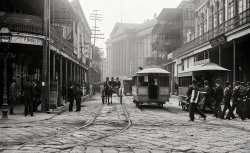
- Trip Advisor: 1902
- ... by Ward Foster in the 1880s. 8x10 glass negative by William Henry Jackson. View full size.
Ocklawaha? Where the heck is ... Posted by Dave - 08/15/2011 - 11:12am -
![Trip Advisor: 1902 1902. "Mr. Foster's office in Palm Beach." An outpost of the Ask Mr. Foster chain of travel agencies and souvenir shops started in Florida by Ward Foster in the 1880s. 8x10 glass negative by William Henry Jackson. View full size.
Ocklawaha?Where the heck is Ocklawaha? I might buy a ticket just to find out.
[It is both a town and a river. - Dave]
Philip Morris ain't hereAt first glance, I thought the boy was dressed in a red bellhop uniform like those who used to page people with phone messages at hotels i.e. "Call for Philip Morris!" but on closer inspection he seems to be a messenger or junior assistant of some sort. Also, just think, 109 years ago, somebody cut some lily of the valley out of their garden in the morning and put them in a water glass on their desk and still today they convey the beauty and fragrance of nature, my mom's favorite flower. The posters, postcards, travel photos, etc. pictured would today get you on TV in the Antiques Roadshow and be worth a hefty sum too. Carry on.
A room loaded with Shorpy fruitLook at those walls full of photos and those stacks of big brochures (or whatever travel agencies used then). One of the eye catchers for sure is the Ocklawaha Steamer Tickets sign (part of one was used for a window sign of some kind). A photo like this is why Google was invented, sort of, where I found some marvelous prose:
St. Johns and Ocklawaha Rivers
(Highways and Byways of Florida, 1918)
Palatka is the starting-point of the Ocklawaha steamers. They go south twenty-five miles, then turn west and enter the old forests of the "dark crooked water," which is what the name of the stream means in English. The journey ends at Silver Springs, one hundred and ten miles farther on. Enthusiasts call the Ocklawaha "the sweetest water-lane in the world," and the voyage through this liquid silent forest aisle is full of weird interest. Certainly no trip to Florida is complete which does not include an outing on this romantic stream with its ever-changing scenes and its tonic air laden with the balsamic odors of the forest.
The latter part of the Ocklawaha journey is made at night, and it is then that the river is seen most impressively after a fire of pine knots has been kindled in a big iron box on the top of the pilot-house. This blazes finely, and the light from the resinous yellow flames advances up the dark sinuosities of the stream in a manner that is enchantingly mysterious. The foliage which it touches is magically green, the festooning mosses are transformed to silvered garlands, the tree trunks turn to corrugated gold, and the black slimy stumps become jeweled pillars. When the fire dies down a little the distant scenery becomes indistinct and shadowy, and the great trees are pallid and ghostly. Then fresh knots are thrown in, the fire blazes up, and again the winding forest walls are brightly lighted amid the impenetrable surrounding mirk, while everything is reflected in the smooth water.
Ocklawaha and Silver RiversAs a photographer I wish I could go back in time and visit this place. I live near the Ocklawaha and Silver Rivers. They haven't changed much since the old days. Here is the Ocklawaha River today.
Here's the Silver River which starts at Silver Spring and flows into the Ocklawaha.
I fell in love with these rivers about 12 years ago and started photographing the flora and fauna. There is a high concentration of wildlife on these two rivers including rhesus monkeys which in itself is an interesting story as to how they got there. Even with the small boat sometimes it's hard to get through. After a big storm there's always trees blocking the rivers and in the old days they must have had a crew working full time to keep the waterway clear.
[One would be hard pressed to tell them apart. - Dave]
Hand Painted Art for sale Ah, hand coloring a black and white photograph. That is a lost art these days. Very few, if any photographers have the time or patience to sit down with a picture and a large box of watercolor type paints with which to hand color a photograph.
I used to do hand spotting of photos and that was hard enough matching the gray-tones to the photo.
Now it is all computerized as displayed on Shorpy.com. We have some artists who excel at digitally colorizing photographs, such as Don W.
Timeshift"Hedonism? Well! Certainly not, Sir!"
(The Gallery, Florida, The Office, W.H. Jackson)](https://www.shorpy.com/files/images/4a20521a.thumbnail.jpg)
- Palm Walk: 1897
- ... Worth, Palm Beach." 8x10 inch dry plate glass negative by William Henry Jackson. View full size.
Coconuts Why Floridians of the past ... Posted by Dave - 04/28/2018 - 1:25pm -
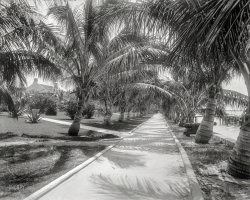
- Cracker Shack: 1897
- ... -- Seville, Fla." 8x10 inch dry plate glass negative by William Henry Jackson. View full size.
Flip-flops, shorts and a tank top ... Posted by Dave - 04/11/2019 - 12:14pm -
![Cracker Shack: 1897 The Sunshine State circa 1897. "A Florida home -- Seville, Fla." 8x10 inch dry plate glass negative by William Henry Jackson. View full size.
Flip-flops, shorts and a tank topEach time I see Florida photos here on Shorpy with people dressed in TOC garb, I marvel at their ability to tolerate those hot, humid summers so heavily dressed.
Shack?I'll take it any day, with a central air upgrade of course. I've lived through more Florida summers than I care to count. Brutal when you don't have the sea breeze. And while I'm whining the humidity is no picnic either.
Chicken WireI'm guessing the chicken wire connecting the upstairs porch to the ground is for pet cat access. That's just a guess.
[It's a trellis for that giant vine. - Dave]
(The Gallery, DPC, Florida, W.H. Jackson)](https://www.shorpy.com/files/images/SHORPY-4a03596a.thumbnail.jpg)
- Colorado Choo-Choo: 1900
- ... Manitou and Pike's Peak Railway." 8x10 glass negative by William Henry Jackson. View full size.
How they did it. Taken a few years ... Posted by Dave - 08/03/2012 - 4:07pm -
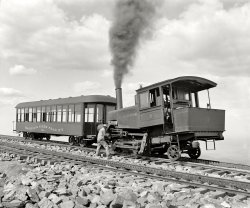
- Hospital Street: 1897
- ... "Hospital Street." 5x7 inch dry plate glass negative by William Henry Jackson, Detroit Photographic Co. View full size.
The Man ... Posted by Dave - 08/16/2012 - 2:11pm -
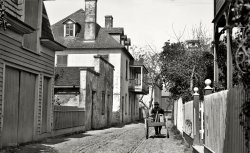
- The Monticello: 1902
- ... Street and City Hall Avenue." 8x10 inch glass negative by William Henry Jackson. View full size.
Family tie Mr great-great-grandfather, ... Posted by Dave - 12/26/2017 - 11:45am -
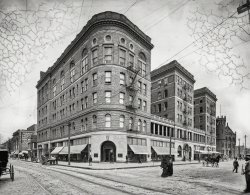
- Poinciana Palms: 1902
- ... "Royal Poinciana Hotel, entrance." 8x10 glass negative by William Henry Jackson, Detroit Photographic Company. View full size.
It ... Posted by Dave - 01/25/2014 - 11:45am -
![Poinciana Palms: 1902 Palm Beach in 1902. "Royal Poinciana Hotel, entrance." 8x10 glass negative by William Henry Jackson, Detroit Photographic Company. View full size.
It didn't burn down!Surprisingly.
It was torn down in 1935 when failing fortunes and the Depression killed it.
And what is there at the site todayCondos
So PristineThe is a perfect example of how some photos from eras gone by look so pristine that you wonder how it could have been possible for them to be so well kept up using the technology of the time. Then again, there are other photos that show so much dirt and garbage in the streets that it is striking. Were some places really that well maintained and others that filthy? It makes me wonder which end of the spectrum was the norm or if that fell somewhere in between squalor and verdant elegance.
[The Royal Poinciana's clientele were the wealthy; they were used to having things neat and tidy, to say the least. -tterrace]
(The Gallery, DPC, Florida, W.H. Jackson)](https://www.shorpy.com/files/images/SHORPY_4a16827a.thumbnail.jpg)
- Canoemobile: 1902
- ... of hybrid transportation. 8x10 inch glass negative by William Henry Jackson, Detroit Publishing Company. View full size.
Tree on the ... Posted by Dave - 08/09/2012 - 6:48pm -
![Canoemobile: 1902 The Adirondack Mountains, New York, circa 1902. "An Adirondack hand cart carry." Yet another example of hybrid transportation. 8x10 inch glass negative by William Henry Jackson, Detroit Publishing Company. View full size.
Tree on the Left of FrameWhat's with the tree on the left it appears to have its bark peeled away in several bands. One at its base somewhat large, then two smaller above that one both about the same size, then one much larger above those.
[Horizontal peeling is typical of the white and paper birch. -tterrace]
Very hybridWhat's being hauled is an Adirondack guide boat, itself a hybrid - not a canoe, not a rowboat, but the best of both. It's been around since the early 19th century. In the photo, it's probably moving between lakes or ponds over a "carry," many of which connect the Fulton Chain of Lakes in the eastern side of the Adirondacks.
I did this For two or three summers, I did portage, or haulage as you will, humpin' anything the camper couldn't or wouldn't. Skiffs, dorys, canoes and home built, though they were some heavy clunkers, I wanted to lecture them on the virtues of birch and cedar over oak and hemlock. But at the end of most trips, I must say they all tried to shoulder out their craft. I miss them, because now I camp alone on Benson Lake.
TreesWhite birch = paper birch.
Both are common names for Betula papyrifera
(The Gallery, Boats & Bridges, DPC, W.H. Jackson)](https://www.shorpy.com/files/images/SHORPY_4a09900a.thumbnail.jpg)
- Ninth & Grace: 1900
- ... Robert E. Lee and Jefferson Davis. 8x10 glass negative by William Henry Jackson. View full size.
Still there! With a few exceptions ... Posted by Dave - 02/28/2019 - 2:43pm -
![Ninth & Grace: 1900 Richmond, Va., circa 1900. "St. Paul's Episcopal Church, Ninth & Grace Streets." The so-called "Cathedral of the Confederacy," attended by Robert E. Lee and Jefferson Davis. 8x10 glass negative by William Henry Jackson. View full size.
Still there!With a few exceptions it's now mostly surrounded by hideous modern buildings but the church itself looks the same.
[Except for that steeple. - Dave]
1 outta 2 eeplesSeems to have lost its steeple, but not its people.
Daring ClimbersRemoved the steeple five years later.
(The Gallery, DPC, Richmond, W.H. Jackson)](https://www.shorpy.com/files/images/SHORPY-4a16993a.thumbnail.jpg)
- Lake Worth: 1897
- ... the Royal Poinciana Hotel." 8x10 inch glass negative by William Henry Jackson. View full size.
Interesting Juxtaposition I don't ... Posted by Dave - 01/30/2019 - 3:49pm -
![Lake Worth: 1897 Palm Beach, Florida, circa 1897. "Lake Worth, south from the Royal Poinciana Hotel." 8x10 inch glass negative by William Henry Jackson. View full size.
Interesting JuxtapositionI don't mean to be pedantic, but this picture is very confusing.
The map shows this would be West Palm Beach according to the lake's location in the picture. There is a causeway across the lake called Royal Poinciana Way and there is a similarly named shopping area on the right side of the lake. However, that would mean the hotel was either in West Palm Beach or the picture is reversed.
Perhaps another reader will clear this up.
[Turn your map upside down. In the photo the mainland is to the right. - Dave]
That would be true if the lake ended not far past the hotel. In the picture it appears to go on much farther.
[Lake Worth, which is not really a lake, has no beginning or end -- it's a lagoon on the Intracoastal Waterway. The hotel was around where Royal Poinciana Plaza is on the map below, on the inland side of the giant sand bar that is Palm Beach. - Dave]
Built with no power tools.I'm always impressed with that. Not to take away anything from today's tradesmen, but they needed some extra skills back then.
Whenever I hear people complaining about automation killing jobs, I ask them how they would like to do things the way they had to 100 years ago.
No thanks!
Roof ladderImagine having to climb out there to raise the flag every day.
An Old MapHere's an old real estate map from 1907 showing the Lake and an inlet at the north end of Palm Beach. Until the mid 1800s the Lake was a fresh water lagoon.
Click to enlarge.
(The Gallery, DPC, Florida, W.H. Jackson)](https://www.shorpy.com/files/images/SHORPY-4a03612a.thumbnail.jpg)























